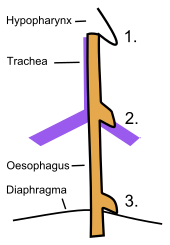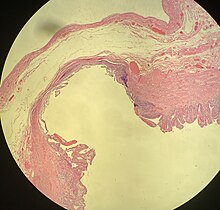Diverticulum
| Diverticulum | |
|---|---|
| Other names | Diverticula |
 | |
| Schematic drawing of a false diverticulum. A - mucosa; B - submucosa; C - muscularis; D - serosa and subserosa | |
| Specialty | Gastroenterology |
In medicine orbiology,adiverticulumis an outpouching of a hollow (or a fluid-filled) structure in the body.[1]Depending upon which layers of the structure are involved, diverticula are described as being either true or false.[2]
In medicine, the term usually implies the structure is not normally present, but inembryology,the term is used for some normal structures arising from others, as for instance thethyroid diverticulum,which arises from thetongue.[3]
The word comes from Latindīverticulum,"bypath" or "byway".
Classification
[edit]Diverticula are described as being true or false depending upon the layers involved:
- False diverticula (also known as "pseudodiverticula" ) do not involve muscular layers or adventitia. False diverticula, in the gastrointestinal tract for instance, involve only thesubmucosaandmucosa,such asZenker's diverticulum.[2]False diverticula are typically synonymous withpulsion diverticula,which describes the mechanism of formation as increased intraluminal pressure.
- True diverticula involve all layers of the structure, includingmuscularis propriaandadventitia,such asMeckel's diverticulum.[2]True diverticula are typically synonymous with traction diverticula, which describes the mechanism of formation as pulling forces external to the structure.
Embryology
[edit]- Thekidneysare originally diverticula in thedevelopment of the urinary and reproductive organs.
- Thelungsare originally diverticula forming off of the ventral foregut.[3]
- Thethymusappears in the form of two flask-shape diverticula, which arise from the thirdbranchial pouch(pharyngeal pouch) of theendoderm.[4]
- Thethyroidgland develops as a diverticulum arising from a point on the tongue, demarcated as theforamen cecum.[3]

Human pathology
[edit]Gastrointestinal tract diverticula
[edit]- Esophageal diverticula may occur in one of three areas of the esophagus:
- Pharyngeal (Zenker's) diverticula usually occur in the elderly, throughKillian's trianglebetween thethyropharyngeusandcricopharyngeus muscleof theinferior pharyngeal constrictors.
- Midesophageal diverticula
- Epiphrenic diverticula are due to dysfunction of the lower esophageal sphincter, as inachalasia.[5]
- A duodenal diverticulum can be found incidentally in 23% of normal people undergoing imaging. It can be either congenital or acquired, but the acquired form is more common and is due to the weakness of the duodenal wall, which causes protrusions. It is usually found at thesecond or third part of duodenum,around theampulla of Vater.Food debris may enter the diverticular outpouchings, causing inflammation or diverticulitis. On CT or MRI imaging, it appears as a sac-like outpouching. If the diverticulum is filled withcontrast agents,the wall would be thin and may contain air, fluid, contrast material, or food debris. If the food debris is broken down by bacteria, the outpouching may show "faeces sign". Inflammation of the duodenal wall shows thickening of the wall. Rarely, on barium studies in congenital duodenal diverticula, the contrast material fills up the true lumen, causing "windsock"deformity.[6]
- A jejunal diverticulum is a congenital lesion and may be a source of bacterial overgrowth. It may also perforate or result in abscesses.
- AKillian-Jamieson diverticulumis very similar to a pharyngeal esophageal diverticulum, differing in the fact that the pouching is between the oblique and transverse fibers of thecricopharyngeus muscle.[7]
- ALaimer diverticulumis an outpouching that occurs in the Laimer triangle between thecricopharyngeusand superior esophageal circular muscle.
- Colonic diverticula,although found incidentally during colonoscopy, may become infected (seediverticulitis) and can perforate, requiring surgery.[8]
- Gastric diverticula are very infrequent.[9]
- Meckel's diverticulum,a persistent portion of theomphalomesenteric duct,is present in 2% of the population,[10]making it the most common congenital gastrointestinal malformation.[11]

- Rokitansky-Aschoff sinusesare diverticula in thegallbladderdue to chroniccholecystitis[12]
Most of these pathological types of diverticula are capable of harboring anenterolith.If the enterolith stays in place, it may cause no problems, but a large enterolith expelled from a diverticulum into thelumencan cause obstruction.[13]
Genito-urinary tract diverticula
[edit]- Bladder diverticula are balloon-like growths on the bladder commonly associated with chronic outflow obstruction, such asbenign prostatic hyperplasiain older males. Usually found in pairs on opposite sides of the bladder, bladder diverticula are often surgically removed to prevent infection, rupture, or even cancer.
- Calyceal diverticula are usually asymptomatic, but if a stone becomes lodged in the outpouching, they may present with pain.[14]
- Urethral diverticula are usually found in women aged 30 to 70 years old, in between 1 and 6% of adult women. Since most cases are without any symptoms, the true incidence is unknown. Symptoms may vary from frequent urinary tract infections, painful sexual intercourse (dyspareunia), or symptoms due to cancer. A urethral diverticulum is located on the anterior vaginal wall, 1 to 3 cm inside thevaginal introitus.MRI is preferred as the imaging method of choice due to its excellent soft-tissue resolution. OnT2-weighted imaging,it shows a high signal in the diverticulum due to the presence of fluid inside it.Vaginal ultrasonographyis highly sensitive in diagnosing the diverticulum, but it is strongly dependent on the skills of the operator.[15]
Other diverticula
[edit]- Adiverticulum of Kommerellis an outpouching (aneurysm) of the aorta where an aberrant right subclavian artery is located.[16]It is unusual nomenclature, in that focal dilatations of a blood vessel are properly referred to as aneurysms.
- Cardiac diverticulum is a very rare congenital malformation of the heart that is usually benign.[17]
Gallery
[edit]-
Meckel's diverticulum
-
Large bowel (sigmoid colon) showing multiple diverticula: the diverticula appear on either side of the longitudinal muscle bundle (taenium).
-
Colonic diverticulum
-
Diverticulum of the urinary bladder of a 59-year-old man, transverse plane
-
Bladder diverticula containing stones: the bladder wall is thickened due to possibletransitional cell carcinoma.
-
Bladder diverticula as seen on ultrasound with doppler[18]
-
Bladder diverticula as seen on ultrasound[18]
See also
[edit]References
[edit]- ^"diverticulum | Definition of diverticulum in English by Lexico Dictionaries".Lexico Dictionaries | English.Archived fromthe originalon 17 July 2019.Retrieved17 July2019.
- ^abcTownsend, Courtney M. Jr.; Daniel Beauchamp, R.; Mark Evers, B.; Mattox, Kenneth L. (2017).Sabiston Textbook of Surgery: The Biological Basis of Modern Surgical Practice(20th ed.). Philadelphia, PA.ISBN9780323299879.OCLC921338900.
{{cite book}}:CS1 maint: location missing publisher (link) - ^abcSadler, Thomas W. (2012).Langman's Medical Embryology(12th ed.). Philadelphia: Wolters Kluwer Health/Lippincott Williams & Wilkins.ISBN9781451113426.OCLC732776409.
- ^Standring, Susan (2016).Gray's Anatomy: The Anatomical Basis of Clinical Practice(41st ed.). [Philadelphia].ISBN9780702052309.OCLC920806541.
{{cite book}}:CS1 maint: location missing publisher (link) - ^Yam, Julie; Ahmad, Sarah A. (2019),"Esophageal Diverticula",StatPearls,StatPearls Publishing,PMID30422453,retrieved17 July2019
- ^Barat, M.; Dohan, A.; Dautry, R.; Barral, M.; Boudiaf, M.; Hoeffel, C.; Soyer, P. (October 2017)."Mass-forming lesions of the duodenum: A pictorial review".Diagnostic and Interventional Imaging.98(10): 663–675.doi:10.1016/j.diii.2017.01.004.PMID28185840.
- ^O'Rourke, Ashli K.; Weinberger, Paul M.; Postma, Gregory N. (May 2012)."Killian-Jamieson diverticulum".Ear, Nose, & Throat Journal.91(5): 196.doi:10.1177/014556131209100507.ISSN1942-7522.PMID22614553.
- ^Feuerstein, Joseph D.; Falchuk, Kenneth R. (August 2016)."Diverticulosis and Diverticulitis".Mayo Clinic Proceedings.91(8): 1094–1104.doi:10.1016/j.mayocp.2016.03.012.ISSN1942-5546.PMID27156370.
- ^Shah, Jamil; Patel, Kalpesh; Sunkara, Tagore; Papafragkakis, Charilaos; Shahidullah, Abul (April 2019)."Gastric Diverticulum: A Comprehensive Review".Inflammatory Intestinal Diseases.3(4): 161–166.doi:10.1159/000495463.ISSN2296-9365.PMC6501548.PMID31111031.
- ^Elsayes, Khaled M.; Menias, Christine O.; Harvin, Howard J.; Francis, Isaac R. (July 2007). "Imaging manifestations of Meckel's diverticulum".AJR. American Journal of Roentgenology.189(1): 81–88.doi:10.2214/AJR.06.1257.ISSN1546-3141.PMID17579156.S2CID45677981.
- ^Sagar, Jayesh; Kumar, Vikas; Shah, D. K. (October 2006)."Meckel's diverticulum: a systematic review".Journal of the Royal Society of Medicine.99(10): 501–505.doi:10.1177/014107680609901011.ISSN0141-0768.PMC1592061.PMID17021300.
- ^Stunell, H; Buckley, O; Geoghegan, T; O’Brien, J; Ward, E; Torreggiani, W (2008). "Imaging of adenomyomatosis of the gall bladder".Journal of Medical Imaging and Radiation Oncology.52(2): 109–117.doi:10.1111/j.1440-1673.2008.01926.x.ISSN1754-9477.PMID18373800.S2CID42685012.
- ^Chaudhery B, Newman PA (2014)."Small bowel obstruction and perforation secondary to primary enterolithiasis in a patient with jejunal diverticulosis".BMJ Case Reports.2014:bcr2014203833.doi:10.1136/bcr-2014-203833.PMC3962938.PMID24626387.
- ^Oxford American Handbook of Urology.Albala, David M. Oxford: Oxford University Press. 2011.ISBN9780199707720.OCLC655896560.
{{cite book}}:CS1 maint: others (link) - ^Greiman, Alyssa K.; Rolef, Jennifer; Rovner, Eric S. (2 January 2019)."Urethral diverticulum: A systematic review".Arab Journal of Urology.17(1): 49–57.doi:10.1080/2090598X.2019.1589748.ISSN2090-598X.PMC6583718.PMID31258943.
- ^Raymond, Steven L.; Gray, Sarah E.; Peters, Keith R.; Fatima, Javairiah (25 June 2019)."Right-sided aortic arch with aberrant left subclavian artery and Kommerell diverticulum".Journal of Vascular Surgery Cases and Innovative Techniques.5(3): 259–260.doi:10.1016/j.jvscit.2019.02.009.ISSN2468-4287.PMC6600077.PMID31304436.
- ^Vazquez-Jimenez, Dr. Jaime (2003)."Cardiac diverticulum"(PDF).Orphanet Encyclopedia.Retrieved14 January2008.
- ^ab"UOTW #56 - Ultrasound of the Week".Ultrasound of the Week.21 August 2015.





